Mrexcell
On this page, you find all documents, package deals, and flashcards offered by seller MrExcell.
- 132
- 0
- 9
Community
- Followers
- Following
141 items
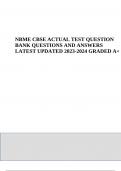
NBME CBSE ACTUAL TEST QUESTION BANK QUESTIONS AND ANSWERS
Osteoclast Activity Cohot Study of elderly women - relative risk ratio for hip fractures among those who exercise regularly is 1.2 (95% confidence interval of 1.1 to 1.8). Which of the following is the conclusion about the effect of exercise on the risk of hip fracture? -Answer= Statistically Significant Overall Increase Risk 52 year old man goes to ER with chest pain radiating to his jaw while shoveling snow. Pulse is 80/min and blood pressure is 130/70. The most immediate treatment mech...
- Exam (elaborations)
- • 370 pages •
Osteoclast Activity Cohot Study of elderly women - relative risk ratio for hip fractures among those who exercise regularly is 1.2 (95% confidence interval of 1.1 to 1.8). Which of the following is the conclusion about the effect of exercise on the risk of hip fracture? -Answer= Statistically Significant Overall Increase Risk 52 year old man goes to ER with chest pain radiating to his jaw while shoveling snow. Pulse is 80/min and blood pressure is 130/70. The most immediate treatment mech...

TNCC Final Exam Test Open Book Questions And Answers Rated A+
Why is a measure of serum lactate obtained in the initial assessment of the trauma patient? Answer: c - a) to measure oxygenation and ventilation b) to quantify the base deficit for the adequacy of cellular perfusion c) *to gauge end-organ perfusion and tissue hypoxia ** d) to determine the underlying cause of shock A trauma patient is restless and repeatedly asking "where am I?" vital signs upon arrival were BP 100/60 mm Hg, HR 96 beats/min, and RR 24 breaths/min. Her skin is cool and...
- Exam (elaborations)
- • 23 pages •
Why is a measure of serum lactate obtained in the initial assessment of the trauma patient? Answer: c - a) to measure oxygenation and ventilation b) to quantify the base deficit for the adequacy of cellular perfusion c) *to gauge end-organ perfusion and tissue hypoxia ** d) to determine the underlying cause of shock A trauma patient is restless and repeatedly asking "where am I?" vital signs upon arrival were BP 100/60 mm Hg, HR 96 beats/min, and RR 24 breaths/min. Her skin is cool and...
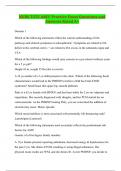
NURS 7375 ANCC Practice Exam Questions and Answers Rated A+
Domain 1 Which of the following statements reflect the current understanding of DA pathways and clinical symptoms in schizophrenia? -Symptoms are related to DA deficit in the cerebral cortex; + are related to DA excess in the substantia nigra and VTA Which of the following findings would raise concern in a pre-school wellness exam for a 5 yo girl? Height 43 in, weight 55 lbs (she is overwt) A 24 yo mother of a 2 yo child presents to the clinic. Which of the following facial characteristics w...
- Exam (elaborations)
- • 49 pages •
Domain 1 Which of the following statements reflect the current understanding of DA pathways and clinical symptoms in schizophrenia? -Symptoms are related to DA deficit in the cerebral cortex; + are related to DA excess in the substantia nigra and VTA Which of the following findings would raise concern in a pre-school wellness exam for a 5 yo girl? Height 43 in, weight 55 lbs (she is overwt) A 24 yo mother of a 2 yo child presents to the clinic. Which of the following facial characteristics w...
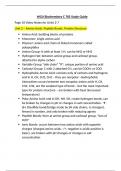
WGU Biochemistry C 785 Study Guide
Page 10 Video Notes for Units 2-7 Unit 2 – Amino Acids, Peptide Bonds, Protein Structure Amino Acid: building blocks of proteins Monomer: single amino acid Polymer: amino acid chain of linked monomers called polypeptides Amino Group: N with at least 1 H, can be NH2 or NH3 Hydrogen Hat: between amino group and carboxyl group, attached to alpha carbon Variable Group “side chain” “R”: unique portion of amino acid Carboxyl Group: C with 2 attached O’...
- Exam (elaborations)
- • 42 pages •
Page 10 Video Notes for Units 2-7 Unit 2 – Amino Acids, Peptide Bonds, Protein Structure Amino Acid: building blocks of proteins Monomer: single amino acid Polymer: amino acid chain of linked monomers called polypeptides Amino Group: N with at least 1 H, can be NH2 or NH3 Hydrogen Hat: between amino group and carboxyl group, attached to alpha carbon Variable Group “side chain” “R”: unique portion of amino acid Carboxyl Group: C with 2 attached O’...
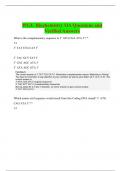
WGU Biochemistry OA Questions and Verified Answers
What is the complementary sequence to 3’ ATG CGA ATA 5’? * 1/1 3’ TAT TCG CAT 5’ 3’ TAC GCT TAT 5’ 3’ GAT AGC ATA 5’ 5’ ATA AGC GTA 3’ Which amino acid sequence would result from this Coding DNA strand? 3’ ATG CAG ATA 5’? * 1/1 Tyr Val Tyr Ile Gln Ile Ile Asp Val Leu His Lys Which amino acid sequence would be made from this template DNA strand? 5’ TAT TAC CGA 3’? * 0/1
- Exam (elaborations)
- • 72 pages •
What is the complementary sequence to 3’ ATG CGA ATA 5’? * 1/1 3’ TAT TCG CAT 5’ 3’ TAC GCT TAT 5’ 3’ GAT AGC ATA 5’ 5’ ATA AGC GTA 3’ Which amino acid sequence would result from this Coding DNA strand? 3’ ATG CAG ATA 5’? * 1/1 Tyr Val Tyr Ile Gln Ile Ile Asp Val Leu His Lys Which amino acid sequence would be made from this template DNA strand? 5’ TAT TAC CGA 3’? * 0/1
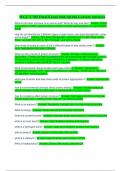
WGU C785 Final Exam with All the Correct Answers
What is the basic structure of an amino acid? What do they look like? -Answer- amino group (NH2 or NH3), carboxyl group (COO or COOH), alpha carbon (C), and variable group How do you identify the 3 different types of side chains: non-polar/hydrophobic, polar, and charged? -Answer- Non-polar/hydrophobic - end with CH or "can't have" water. Polar - end with OH, SH, or NH. Charged - end with a charge what kinds of bonds do each of the 3 different types of side chains make? -Answerionic, hy...
- Exam (elaborations)
- • 17 pages •
What is the basic structure of an amino acid? What do they look like? -Answer- amino group (NH2 or NH3), carboxyl group (COO or COOH), alpha carbon (C), and variable group How do you identify the 3 different types of side chains: non-polar/hydrophobic, polar, and charged? -Answer- Non-polar/hydrophobic - end with CH or "can't have" water. Polar - end with OH, SH, or NH. Charged - end with a charge what kinds of bonds do each of the 3 different types of side chains make? -Answerionic, hy...
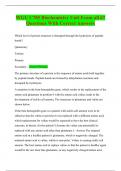
WGU C785 Biochemistry Unit Exam all 67 Questions With Correct Answers
Which level of protein structure is disrupted through the hydrolysis of peptide bonds? Quaternary Tertiary Primary Secondary - Answer Primary The primary structure of a protein is the sequence of amino acids held together by peptide bonds. Peptide bonds are formed by dehydration reactions and disrupted by hydrolysis. A mutation in the beta-hemoglobin gene, which results in the replacement of the amino acid glutamate in position 6 with the amino acid valine, leads to the development of sick...
- Exam (elaborations)
- • 46 pages •
Which level of protein structure is disrupted through the hydrolysis of peptide bonds? Quaternary Tertiary Primary Secondary - Answer Primary The primary structure of a protein is the sequence of amino acids held together by peptide bonds. Peptide bonds are formed by dehydration reactions and disrupted by hydrolysis. A mutation in the beta-hemoglobin gene, which results in the replacement of the amino acid glutamate in position 6 with the amino acid valine, leads to the development of sick...

WGU C785 Biochemistry Unit Exam Questions
Which level of protein structure is disrupted through the hydrolysis of peptide bonds? Quaternary Tertiary Primary Secondary - CORRECT ANSWER Primary The primary structure of a protein is the sequence of amino acids held together by peptide bonds. Peptide bonds are formed by dehydration reactions and disrupted by hydrolysis. A mutation in the beta-hemoglobin gene, which results in the replacement of the amino acid glutamate in position 6 with the amino acid valine, leads to the developm...
- Exam (elaborations)
- • 25 pages •
Which level of protein structure is disrupted through the hydrolysis of peptide bonds? Quaternary Tertiary Primary Secondary - CORRECT ANSWER Primary The primary structure of a protein is the sequence of amino acids held together by peptide bonds. Peptide bonds are formed by dehydration reactions and disrupted by hydrolysis. A mutation in the beta-hemoglobin gene, which results in the replacement of the amino acid glutamate in position 6 with the amino acid valine, leads to the developm...
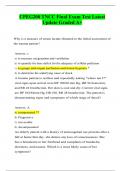
CPEG208 TNCC Final Exam Test Latest Update Graded A+
Why is a measure of serum lactate obtained in the initial assessment of the trauma patient? Answer: c a) to measure oxygenation and ventilation b) to quantify the base deficit for the adequacy of cellular perfusion c) to gauge end-organ perfusion and tissue hypoxia * d) to determine the underlying cause of shock A trauma patient is restless and repeatedly asking "where am I?" vital signs upon arrival were BP 100/60 mm Hg, HR 96 beats/min, and RR 24 breaths/min. Her skin is cool and dry...
- Exam (elaborations)
- • 29 pages •
Why is a measure of serum lactate obtained in the initial assessment of the trauma patient? Answer: c a) to measure oxygenation and ventilation b) to quantify the base deficit for the adequacy of cellular perfusion c) to gauge end-organ perfusion and tissue hypoxia * d) to determine the underlying cause of shock A trauma patient is restless and repeatedly asking "where am I?" vital signs upon arrival were BP 100/60 mm Hg, HR 96 beats/min, and RR 24 breaths/min. Her skin is cool and dry...
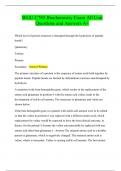
WGU C785 Biochemistry Exam All Unit Questions and Answers A+
Which level of protein structure is disrupted through the hydrolysis of peptide bonds? Quaternary Tertiary Primary Secondary - Answer Primary The primary structure of a protein is the sequence of amino acids held together by peptide bonds. Peptide bonds are formed by dehydration reactions and disrupted by hydrolysis. A mutation in the beta-hemoglobin gene, which results in the replacement of the amino acid glutamate in position 6 with the amino acid valine, leads to the development of sick...
- Exam (elaborations)
- • 49 pages •
Which level of protein structure is disrupted through the hydrolysis of peptide bonds? Quaternary Tertiary Primary Secondary - Answer Primary The primary structure of a protein is the sequence of amino acids held together by peptide bonds. Peptide bonds are formed by dehydration reactions and disrupted by hydrolysis. A mutation in the beta-hemoglobin gene, which results in the replacement of the amino acid glutamate in position 6 with the amino acid valine, leads to the development of sick...
